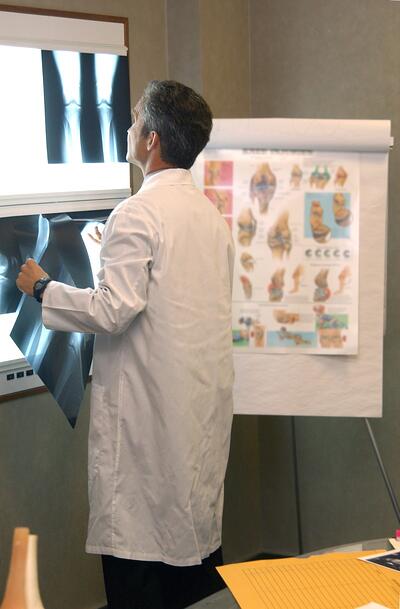Muscle, bone, and joint pain can make day-to-day activities difficult. If this is something you’re struggling with, you may be wondering where to go for help. An orthopedic doctor could be the answer, but many people are unfamiliar with what an orthopedist is, and what they do. In this article, we’re going to break down the information you’re searching for, and help determine if an orthopedic doctor could be right for your condition.
What Is an Orthopedist?
 An orthopedic doctor is a physician that specializes in the musculoskeletal system. The musculoskeletal system gives structure to your body and allows it to move. It’s made up of bones, muscles, cartilage, tendons, ligaments, joints and connective tissue. When an issue arises from these body parts, it’s time to visit an orthopedic doctor.
An orthopedic doctor is a physician that specializes in the musculoskeletal system. The musculoskeletal system gives structure to your body and allows it to move. It’s made up of bones, muscles, cartilage, tendons, ligaments, joints and connective tissue. When an issue arises from these body parts, it’s time to visit an orthopedic doctor.
Extensive educational training is required to become an orthopedic doctor, which includes up to 14 years of school and then continued medical education courses. Your orthopedics doctor will have completed:
- Four years in an undergraduate program
- Four years of medical school
- Five years in an orthopedic residency
- One or two optional years in a specialized area
- An examination by the American Board of Orthopaedic Surgery
- Continued education courses
What’s The Difference Between Orthopaedics and Orthopedics?
You may have seen the word orthopaedics and wondered what the difference between orthopaedics and orthopedics is. It’s a slight spelling difference that actually means very little. They are the same thing, but orthopaedics was the original spelling coined by the French physician Nicholas Andry.
He derived the word from the Greek word for straight (orthos) and child (paideion). This was because the study of orthopedics began by working on children that suffered from a curvature of the spine.
However, as time progressed, the study expanded to include people of all ages, and all conditions of the musculoskeletal system. The spelling orthopedics became commonplace in the United States, but those in higher learning institutions and in Britain, retain the original spelling.
Conditions Treated by an Orthopedic Doctor
Orthopedic doctors can treat a large range of musculoskeletal issues. A primary care physician can treat minor aches and problems, but many conditions require the expertise of an orthopedic doctor. A few examples of conditions that an orthopedist can treat are:
Back Pain
Much of the world’s population suffers from back pain. It’s one of the most common medical problems, affecting eight out of ten people at some point in their lives. The pain can range from mild to severe, and in many cases it can interfere with everyday activities. Back pain is caused by a wide range of issues, including, but not limited to:
- Muscle, ligament, nerve and spine injuries
- Abnormalities in the soft tissues
- Poor posture
- Wear and tear
- Physical stress
- Degenerative disease
In order to determine the cause of your back pain, a medical examination would be necessary. An orthopedist can evaluate your condition and determine the best course of treatment. Most people will find relief with non-surgical treatment, such as physical therapy, injections, or braces. However, a small portion of patients may benefit from surgery to correct structural deformities. An orthopedist would be able to discuss your options with you.
Joint Pain
Pain of the joints, such as arthritis, can cause major disruptions to your life. Joints are put through a lot of wear and tear during our everyday movements. It’s no wonder that we often experience joint pain. According to the CDC, for those that suffer from arthritis, about one in every four, or 15 million people throughout the United States will experience severe joint pain.
Knees and hips are two joints that often give us problems, especially as we age. However, even younger people can have knee or hip issues. Sometimes the wear and tear from exercise is responsible, but sometimes it’s just everyday activities that cause us to have issues. An orthopedist can review your condition, and recommend the best treatment.
An orthopedic doctor is able to perform arthroscopic procedures, which allow them to see inside a joint to diagnose and treat problems. They will usually recommend conservative treatments. However, if it’s needed, an orthopedic surgeon can perform surgeries, such as a joint replacement.
Sprains, Strains, and Soft Tissue Injuries
 Often during sports, exercise, or even everyday activities, we can injure our soft tissues. This includes injuries to the muscles, tendons and ligaments. The most common soft tissue injuries are sprains, strains, contusions, tendinitis, and bursitis.
Often during sports, exercise, or even everyday activities, we can injure our soft tissues. This includes injuries to the muscles, tendons and ligaments. The most common soft tissue injuries are sprains, strains, contusions, tendinitis, and bursitis.
Soft Tissue injuries usually fall into one of two categories, acute injuries, or overuse injuries. Acute injuries are caused by a sudden trauma, such as a fall, twist or blow to the body. Overuse injuries happen slowly, when an activity is repeated often. This often occurs when we are performing the same task over and over again, such as at work. An orthopedist can evaluate your soft tissue injury and recommend the best course of treatment.
Broken Bones
The most common issue people that comes to mind when people think of orthopedists is broken bones, or fractures. When a bone is broken, the orthopedist will usually cast the area to allow the bone to heal properly. In some cases, the orthopedist may need to place metal screws, plates, rods, or other device, to hold the bone in the proper place while it’s healing. Your orthopedic doctor will also work with a physical therapist to insure proper movement of the area, if it’s necessary.
Orthopedic Treatment: Is It Right for You
 The conditions listed above are only some of the issues an orthopedist can help with. If you have any of the following symptoms, you may benefit from the experience of an orthopedist:
The conditions listed above are only some of the issues an orthopedist can help with. If you have any of the following symptoms, you may benefit from the experience of an orthopedist:
- Pain in muscles, tendons or joints that lasts more than a few days
- Limited range of motion, such as an inability to straighten the back, or a limb
- Joint deformity
- Difficulty using a body part to perform daily functions, such as walking
- Swelling around a joint or the location of an injury
Orthopedic treatment can help with many conditions, but it isn’t for everyone. The only way to know for sure is to have a consultation. Don’t let pain interfere with your life. Contact an orthopedic specialist to schedule an appointment. You may be able to find the relief and comfort you’re seeking.

